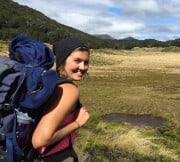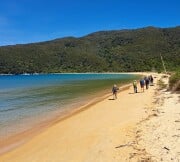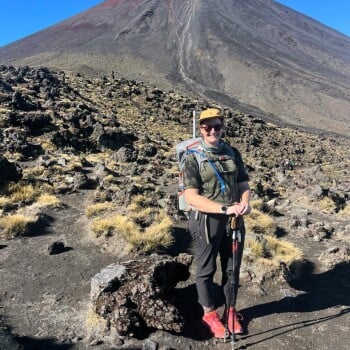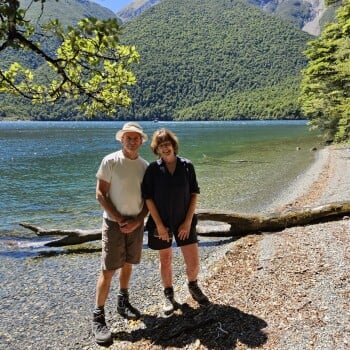
When we’re out hiking, getting in enough fluids to replace those lost to perspiration and exposure to the elements is essential to ensuring we keep our bodies healthy and functioning optimally for the duration of our hike.
But just how much is enough?

Staying hydrated while hiking
On first impressions, the question might well appear to belong to the same category as those of the “how long is a ball of string?” ilk. However, gauging how much water to take with you on a hike is far more measurable and exact a science than many are apt to think.
Below, we aim to show you how that gauging and measuring’s done with a short guide that will help you stay hydrated and healthy on any type or length of hike.
Do your pre-trip research
Before heading on your hike, try to get your hands on any guides, maps, and trip reports to identify water sources along your route. If these happen to be abundant, then it will save you having to schlep your full supply of H20 with you from the trailhead; if they’re less frequent or only seasonal, then you’ll simply have to bite the bullet and haul the requisite amount needed to keep yourself adequately hydrated.
*If using wild water sources, be sure to pack a reliable and effective water purification system.
Do the math
The old-school rule of thumb that has served many a hiker well over the years has been to aim to drink one liter of water per two hours of hiking. However, as this figure may seem a touch arbitrary and is dependent on a number of variables, below we’ll look at ways you can gauge your required water intake more accurately in varying conditions.
Hiking time
Your first step should be to determine not just the overall mileage of your intended route, but the time you expect to take to complete it. Some shorter hikes may lack mileage but because of their steepness, the ruggedness of the terrain, and the elevation at which they take place, they may demand far more exertion and take more time than longer hikes on more moderate trails or at lower altitudes.
One of the most effective ways to calculate how long any hike will take is to use Naismith’s Rule, which advises allowing one hour for every three miles of hiking plus an additional hour for every 600m of ascent. A 9-mile hike with 900 meters of ascent, therefore, should take in the region of 4.5 hours, depending on your fitness levels and the nature of the terrain and conditions underfoot.
Water quantities
Once you’ve calculated the amount of time you expect to be on the trail, you should aim to carry enough water to allow yourself 250ml of water per half hour on the trail or one liter per two hours of hiking. This figure, however, represents merely a baseline allowance that may be affected by a number of variable...
Account for variables
Temps
The biggest variable in determining just how much water you’ll need to carry on any given hike is the temperature. While in cooler conditions the ballpark recommendation above of one liter per two hours of trail time will most likely be more than adequate, if out on a desert trail or hiking in midsummer, then you’ll probably need to supplement your baseline allowance with an added half liter per hour of walking in order to replenish lost fluids.
Slowest member
Unless we happen to be of a particularly antisocial disposition, when hiking in a group we can only go as fast as the slowest member of our team. This means that even if we happen to be very fit and particularly swift of foot, then we will be out on the trails for as long as the rest of the team lest we let out conscience lapse and leave them to their own devices. With regard to hydration, this means taking enough water to see us through longer times on the trail—even though moving at lower speeds or spending a significant amount of time waiting, being exposed to the sun and elements can leave us just as parched as putting in serious mileage.
Terrain
Differing types of terrain take different tolls on the body. Both conditions underfoot and more general, large-scale variations such as rugged terrain, scrambling sections, and sustained ups and downs can all make for thirsty work…
Level of exertion
The level of exertion likely on any given trail is usually easy to determine by measuring the overall ascent and the steepness of the trail, but a few other factors can also increase exertions levels and have us working up a thirst in a hurry. The most notable of these are a heavy pack and the altitude at which our hike takes place. If you’re carrying a ponderous load or tackling a trail above the 2,500m mark, therefore, be prepared to carry an extra few hundred ml of water per hour of hiking.
Personal metabolism and absorption rates
In every group of hiking friends there is usually at least one member who guzzles twice as much H20 as his/her companions and another who boasts the drinking habits of your average camel, seeming to be none the worse for taking just a few sips on even the most epic of hikes. The take-home? When calculating how much water to carry, take into account your own needs and adjust the amount of water your carry accordingly. If unsure, follow the guidelines listed above.
How to Store Your Water
Once we’ve determined how much water we need to carry with us on the trail, our next step is to choose how we will do the carrying. The three main options for water portation are hard-sided bottles, hydration bladders, and collapsible bottles. While the option you choose will ultimately come down to personal preferences, each system has a number of pros and cons that may sway your decision.
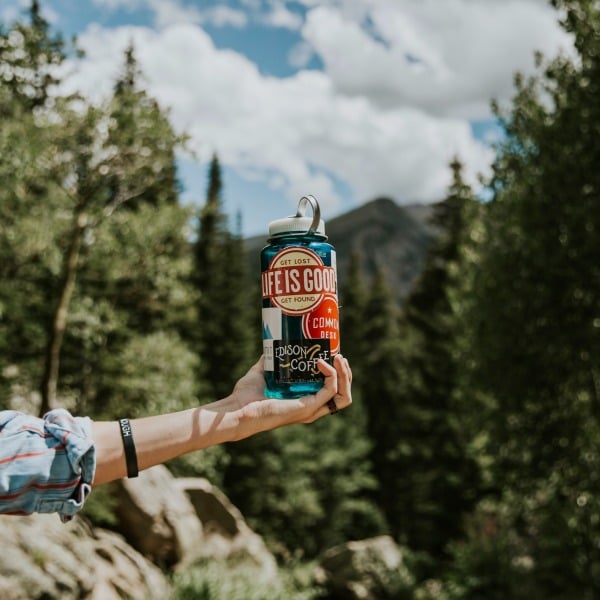
Hard-sided, plastic or aluminum bottles
Advantages
- Easy to refill
- Measurement indicators on plastic bottles helpful when cooking
- Durable
- Easy to clean
Disadvantages
- Bulkier and usually heavier than collapsible bottles and hydration bladders
- Size of the bottle does not adapt to the changing quantity of water inside
Hydration Reservoirs & Bladders
Advantages
- Allows you to hydrate without having to stop and take off your backpack
- High capacity
- Convenient to pack and carry
Disadvantages
- Often tricky to refill from natural sources
- Water in the hose is more susceptible to freezing in cold temperatures
- Easy to inadvertently spill contents if you accidentally compress the mouthpiece
- Tricky to clean and dry out
Collapsible water bottles
Advantages
- Lightweight
- Highly packable
- Adaptable to the amount of liquid being carried
Disadvantages
- Often lack durability
- Difficult to clean and dry
Know the Dangers of Dehydration
With so many other factors occupying our minds during a hike, it can be very easy to forget to hydrate adequately. Proper hydration, however, is crucial to maintaining our body’s ability to regulate heat, stave off thirst and cramps, and avoid the far worse symptoms of one of hiking’s most common and underestimated ailments—dehydration.
Symptoms of Dehydration
The most common signs and symptoms of dehydration include the following:
- Thirst
- Headache, fatigue, weakness, irritability, light-headedness
- Diminished urine output
- Dark or pungent urine
- Symptoms of shock
- Disorientation
Treating Dehydration
Most cases of dehydration can be treated with rehydration salts, rest, and removal from exposure to the sun.
If you suspect you or any member of your team is suffering from dehydration, take the following steps:
- Stop hiking and sit the afflicted member down
- Lie down in a cool, shady spot with your feet elevated
- Take small sips of water mixed with rehydration salts or a salt and sugar solution
As with the vast majority of ailments out there, prevention is far easier than a cure.
Article written by - Jenn Jackson

